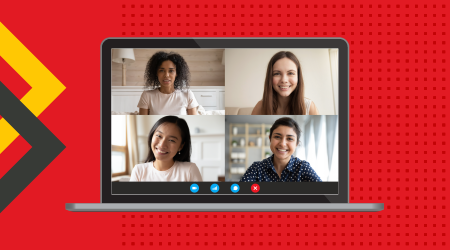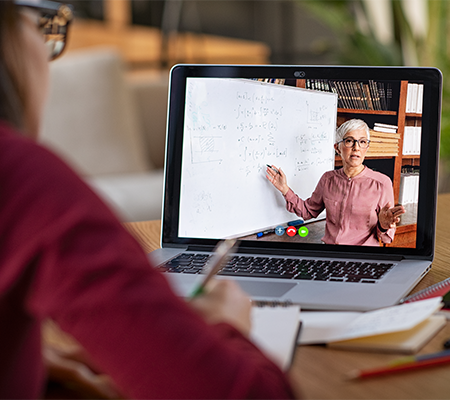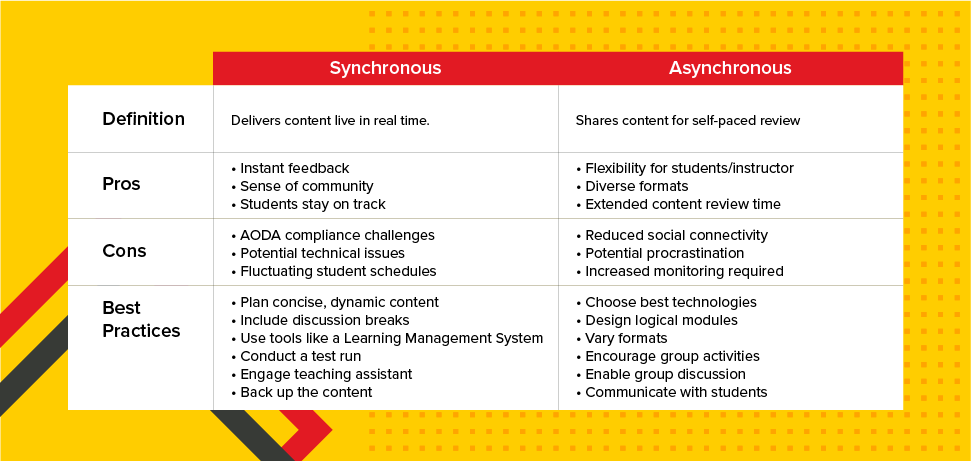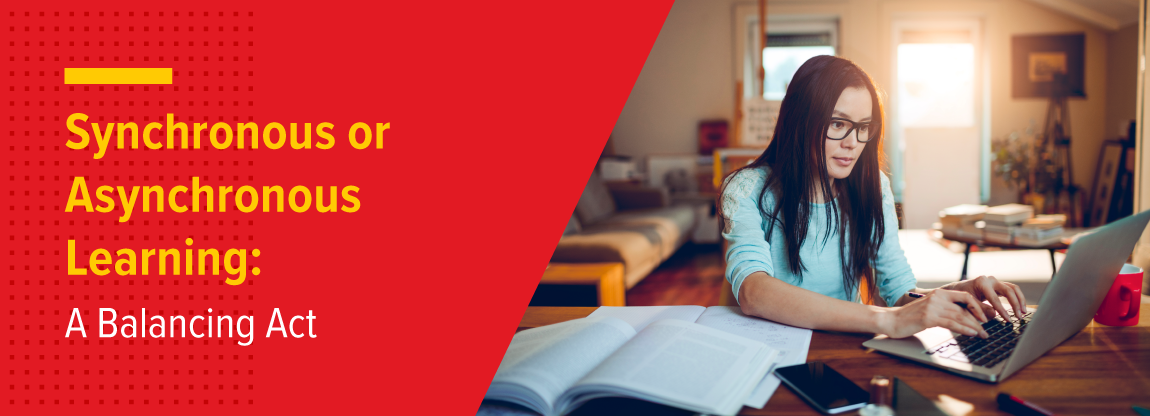Synchronous or Asynchronous Learning: A Balancing Act
The sudden onset of the global pandemic has shone a new light on the art of teaching, as campuses shut down and instructors search for the best ways to deliver their programs remotely. Content must align with the tools of online learning; student engagement poses a unique challenge; and educators may feel overwhelmed as they adjust their protocols.
Achieving the right balance between synchronous and asynchronous learning is a matter of debate. Learning that is synchronized to real time most closely simulates the practices of the lecture hall; while its antithesis, asynchronous learning, features content that is reviewed by the students at their own pace. Each method has a specific place and purpose, with its own set of benefits and drawbacks.


A Closer Look
Remote synchronous learning echoes the face-to-face interactions of the classroom. Live presentations can be streamed through tools like Zoom, Webex, or Go-to-Meeting, with students participating in discussions with their colleagues and the instructor.
Asynchronous learning delivers the content units through a shared system, allowing students to access the course materials at different times, working at their own pace. Educators can record lectures, post assignments, create activities, and provide feedback on a flexible basis.
The Pros and Cons
Synchronous Learning
During live sessions, students can ask questions in real time, letting the instructor assess their understanding and make changes as needed. Breakout group activities and online chats promote a sense of community among the students. The fixed timetable keeps them on track and up to date.
However, AODA compliance is more problematic (for example, captioning live presentations); technical issues may arise; and attention spans may wane. And, with students working from their homes during COVID-19, there are other considerations. They may be managing part-time jobs, supporting sick family members, struggling with unstable internet, or living in different time zones.
Asynchronous Learning
Flexibility is the key benefit of pre-recorded, self-paced learning units, for both the instructor and the students. Complex topics can be explained in various ways; for instance, through step-by-step illustrations. Students can study the course materials on their own schedule, research the concepts in depth, and take the time to formulate thoughtful questions. Centralized, organized content, including discussion boards, also facilitates easy review before tests or final examinations.
The downside of asynchronous learning is its reduced social connectivity and the potential for procrastination. Educators will need to carefully monitor their students’ capacities for independent learning skills and discipline.
Best Practices
Synchronous Learning
Remote teaching, even in real time, demands a special approach to replace in-class learning. Plan your content with awareness of its challenges: prepare lectures that are concise and dynamic; break them up with frequent interludes for discussion; gauge your students’ comprehension; and encourage those who may not feel confident. Select the best technology: there are many options available, including learning management systems that can integrate with publisher courseware, while enabling video conferencing and interactive dialogue. Do a test run before delivering your presentation to the students. If possible, arrange for an assistant to monitor comments and questions, and to deal with any technical issues. And back up the experience with the same content for ongoing online access; for example, record the lecture and provide external resources on the topic.


Asynchronous Learning
There are many platforms for remote teaching: explore and choose the technologies that will share and save your content most effectively, and then make sure that your students know how to use these tools. Design logically sequenced modules, incorporating a variety of formats: recorded lectures, podcasts, external readings, video or audio presentations. Develop activities to inspire interaction with the content, such as quizzes, polls, multiple-choice questions, Q&A sessions, discussion boards. Supplement the self-guided content with personal email communications and chat forums to replace the culture of the classroom. Organize small groups, perhaps designating alternating leadership roles, to collaborate on assignments. And clearly outline the tasks and due dates, with emailed reminders, to make sure that no one falls behind.
A Hybrid Approach
Both practices have a distinct purpose and process. Content can be delivered, reviewed, and considered through an asynchronous approach; then the real-time digital space serves as a sharing platform for in-depth analysis, informed questions, and lively discussions.
The key elements in teaching are communication, planning, and community. Make yourself available to your students, and check in regularly. Allow ample time for feedback and support, while clearly outlining schedules and goals. Create a virtual social group through peer collaboration and stimulating activities.
As partners in education, these two models form a hybrid solution that exploits the advantages of each to ensure positive learning outcomes in the remote teaching environment.



